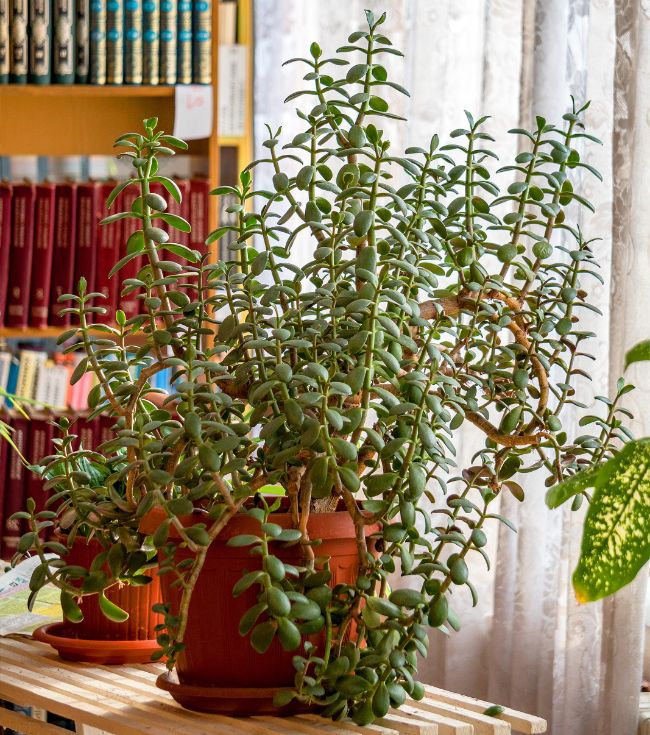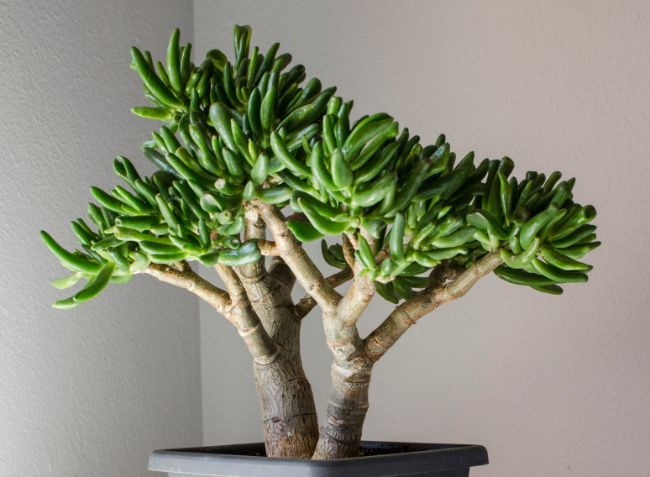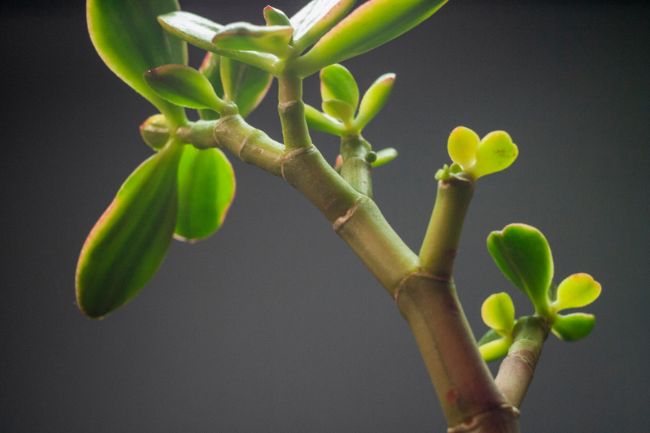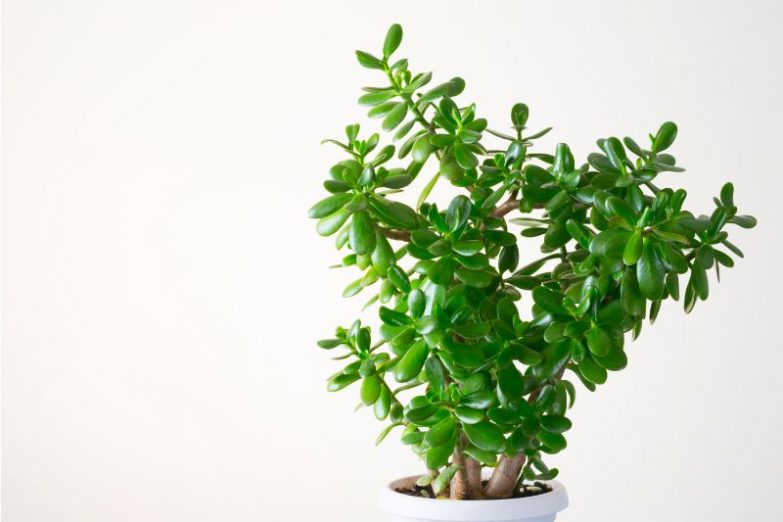The Jade Plant (Crassula ovata) is popular for both its attractive, distinctive look and its ease of care. Their longevity means they can grow quite large, but pruning is more than a defense against an oversized plant – it can be used artistically to shape its structure into different forms. In this article, we’ll explain how to prune a Jade Plant and get the results you want.
How to prune a Jade Plant: Though it grows rather slowly, Jade plants respond well to pruning. Judicious trimming keeps it the right size and helps the structure stay open and healthy. By cutting above a node with a sterile tool, you can stimulate branching and direct the plant’s eventual shape and leaf density.
Overview Of Jade Plant Pruning
Jade plants (Crassula ovata) need strong light and should be watered sparingly, but are otherwise quite easy to care for (see my guide to caring for Jade Plants here). Their primary maintenance chore is occasional pruning, if only to maintain a manageable size.
Trimming isn’t difficult to master, and it’s not a hardship for the plant either. As if to show there’s no hard feelings, they reliably sprout new branches beneath the site of the cuts.
Besides maintaining size, there are other reasons to prune a Jade Plant:
- Plant Health – Pruning eliminates dead or damaged material that can attract pests or disease.
- Decongestion – Removing overly dense foliage lets in light and air for better growth.
- Strengthening and Support – A Jade’s stems don’t always keep up with the foliage. Tall Jades can become top-heavy; leggy branches can sag or even break as their water-storing leaves fatten up after a soaking. Pruning also helps encourage sturdier stems.
- Rescue Work – Severe pruning is a way to start over if disaster strikes. If you cut a plant back severely (and give it good care), its new growth will be strong, full, and vigorous.
- Shaping – Whether you want a statuesque tree form or a filled-out bush, proper pruning can create the look you want.
Pruning may feel uncomfortable at first but gets easier with experience. Results don’t happen quickly, but in time you can achieve the look you want.

When Should You Prune A Jade Plant?
The best time to prune a Jade plant is in spring or early summer, when the plant is growing strongly. The plant will be well equipped to recover from the stress of pruning and produce vigorous new growth.
Look out for drooping branches as a warning sign your Jade Plant is getting overgrown and needs a trim: the woody stems are at risk of breaking.
Pro Tip: Observe the plant after it’s been thoroughly watered – weak branches that remain upright under dry leaves may sag as their foliage becomes laden with water.
Here are things to keep in mind:
- It’s best to wait until the plant is a year old. Young Jades are still developing their roots and central trunk in the first year, and pruning too soon can stunt them.
- Only prune once your Jade has at least eight to ten adult leaves.
- Choose thick stems to prune. The thicker the stem, the more branching it’s likely to do. A thin stem may only produce one new shoot! Good light produces thicker stems.
Types of Pruning
Tailor your pruning method to its purpose:
Taming Overgrowth
When trimming an overgrown plant, don’t simply cut it down to the shape you want. A Jade Plant isn’t a hedge! Prune for overall balance and future growth.
When resizing a plant, take the opportunity to remedy lopsided growth and open up its interior.
Strengthening Weak, Leggy Branches
A plant that has grown congested or has inadequate light will develop sparse, leggy stems that are too thin to support the foliage (read my guide to fixing a leggy Jade Plant here).
Trim these skimpy branches back to as much as a third of their original length. This will conserve the plant’s energy and, with proper care, stimulate healthier growth.
Saving A Distressed Plant
Drastic cutbacks are sometimes needed to salvage a sick plant. Remove all diseased, yellowing, or pest-ridden limbs, including branches with leaves damaged by sunburn or another cause.
It can be discouraging when you have to prune a Jade Plant severely, but don’t lose heart! It’s surprising how resilient a Jade Plant can be.
Artful Jade Plant Pruning
A Jade Plant’s natural response to pruning makes it possible to create the plant you want. Some experienced growers remove foliage selectively to highlight the inner branching structure … but that’s only one option.
The most popular Jade Plant shapes are the rounded, bushy form and the tree-like columnar structure.

The Jade Tree
Take your time when creating a tree structure. Make sure the plant has adequate light and let it recover between steps.
1) Begin by identifying a fairly straight vertical stem and removing most of its foliage. Leave a few suitable branches, but remove any that droop. Keep some leaves on the lower part of the stem to help it grow thicker.
2) Once the central stem has reached a satisfactory height, pinch off the top to encourage new branching growth. For a natural tree appearance, make lower branches shorter than higher ones.
3) Going forward, routinely prune the top branches to encourage further branching.
4) Once the trunk is an appropriate thickness and there is ample foliage on the top of the plant, remove the lower leaves.
The Jade Bush
The secret to shaping your Jade into a well-filled bush is patient, regular pruning over time. Observe the plant’s reactions and let the new stems thicken a bit between rounds.
1) Begin by pruning the plant into the general shape you want. You can trim some of the lower branches, but keep most in place.
2) Prune leggy, sparse stems back to their source trunk to encourage new branches with fresh foliage.
3) Cut long branches down to just above the point you want new stems to appear.
4) Remove drooping or inward-growing branches to keep the plant growing upward and out.
5) Thin the plant’s center by trimming tangled branches.
Jade Plant Pruning Considerations
These rules will help you avoid setbacks when you prune a Jade Plant:
- Unless you’re specifically removing damaged material, only prune a healthy, growing plant.
- Don’t prune when you’re expecting rain or in highly humid conditions. It’s important that your plant quickly forms a callus over the cuts.
- The best time to prune a Jade Plant is in the spring or early summer before it gets too hot. Warm growing temperatures and bright light help the plant recover more quickly.
- Don’t remove more than 25% to 30% of the plant at one time. Do a big job in stages.
- For the speediest recovery, avoid cutting the main trunk.
- Be careful! You can’t un-prune a stem.
What Tools Are Needed To Prune A Jade Plant?
A Jade Plant’s sap can be mildly irritating to the skin, so it is normally best to wear gloves when you prune a Jade plant.
The proper cutting tool depends upon the thickness of the stem you’re cutting – but, if all you need is a tiny pair of scissors, perhaps you should let the stem thicken first. The ideal tool for substantial woody stems is a pair of bypass shears.
Make sure the blade is sharp so you get a clean cut!
Whichever tool you decide upon, be sure to sterilize the blades. Dipping them in isopropyl (rubbing) alcohol will do the job.
Pro Tip: If you’re pruning a diseased plant or one with a pest infestation, re-sterilize the blade with a quick wipe between cuts.
How To Prune A Jade Plant

Plan Ahead
Before you prune a Jade Plant, take a good look at your plant from all angles and plan which stems are best to cut. Two or possibly more branches will sprout below each cut, so consider the eventual result you want.
It can be helpful to mark which stems to prune with colored tape or yarn. Plan to remove:
- Dead or damaged branches.
- Overgrown or leggy stems.
- Stems that interfere with others or cause congestion.
- Branches growing in the wrong direction or at awkward angles.
A Cut Above
Make each cut just a quarter-inch above one of the branches or nodes located along the Jade’s woody stem. The nub that extends above the node after pruning will die and eventually fall away.
Leaving a short nub between the cut and the node provides a buffer for the growing point: cutting behind the node exposes a longer portion of the stem to the risk of rot or infestation.
The Pruning Process
Pruning an overgrown Jade can be daunting, so take it one step at a time. For best results, stand back frequently to re-evaluate your progress, keeping the final goal in mind.
1) Prune unhealthy branches. Cut them nearly flush against the main stem, but leave a nub to avoid compromising the original trunk.
2) Trim the plant to approximately the desired size, removing up to a third of its height and width. You can prune extra-long stems to just a third of their length.
3) Check for extraneous stems. Prune interfering branches and those growing downward.
4) Clear any areas that remain congested.
4) Check the overall balance and do final shaping.
5) Finish by cleaning up the plant. Remove unsightly little shoots.
Aftercare
Allow the cut surfaces to callus over before watering. Don’t relocate or repot for at least a few weeks, and don’t feed before you see new leaves.
Ensure the plant has ample light so that fresh growth comes in well.
If you are pruning in stages, wait until the plant has produced new stems with leaves and some minimal thickness before trimming again.
Propagation After Pruning A Jade Plant
Those cuttings don’t have to go to waste: they are very easy to propagate!
- Start by selecting cuttings that are four to six inches long and have a few leaves. Wait until the cut has callused over (this can take up to a week).
- You can dip the callused ends into rooting powder, but it’s optional. Likewise, you may want to dip them in cinnamon for anti-fungal protection.
- Plant in well-draining media with good drainage, and give them bright light away from direct sun. Water sparingly but don’t let the medium dry out completely.
Note: Don’t try growing roots in water … the stem will rot! When the new baby plant has put out significant new growth, it’s ready for normal care.
Further Reading
If you’d like to learn more about Jade plant care and how to deal with some of the common problems, check out my other Jade Plant articles.
- Jade Plant Care – Complete guide to growing Crassula ovata.
- Why is my Jade Plant dropping leaves?
- Why does my Jade Plant have yellow leaves?
- Why do Jade Plants turn red?
- Why does my Jade Plant have white spots on the leaves?
- How to fix a leggy Jade Plant.
- How to make a Jade Plant grow faster.
- Why do Jade Plant leaves turn brown?

